Panama Springs S.A., Panama
Situated on an isthmus that connects the continents of South and North America, the Republic of Panama (Panama) is a country with a diverse biosphere that is rich in fauna, plants, and natural resources. Bordering the Republic of Costa Rica to the west and the Republic of Colombia to the east, Panama enjoys access to the Caribbean Sea and the Pacific Ocean. Mountain ranges run through the interior of the country – with the highest point at Volcán Barú reaching 3,474 meters – which give way to plains, rolling hills, and lowlands towards the coasts. The country is endowed with lush tropical jungles, which are fed by natural water springs that meander into hundreds of rivers rich in minerals and nutrients flowing from the mountains.
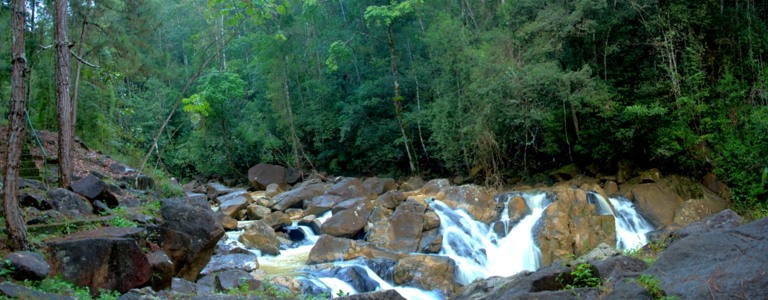
Centuries ago, the indigenous people of the country relied on these rivers for fresh drinking water. When European explorers arrived in the 1500s, they too enjoyed the country’s natural spring water and relied on it for their voyages. Entrepreneurs have sought to utilize Panama’s rich natural resources, including the country’s abundant natural springs. Centuries later, in 2003, Panama Springs S. A. (Panama Springs) – one of the country’s leading domestic bottling companies – launched a new product, Panama Blue, which is made of natural spring water sourced from the same aquifers (a layer of underground rock through which water can flow and be extracted) that have sustained life in the region for eons. Developing an award-winning bottle design that is protected by the intellectual property (IP) system, Panama Blue has become one of Panama’s most popular national products and exports. It is also one out of only a few brands in Panama that uses the country’s name.
Goods with specific geographical origin
A tropical country with two distinct seasons (rainy and dry), Panama is situated between 7 and 10 degrees north of the equator. Temperatures range from an average of 23 degrees Celsius (C) in the mountainous regions to 35C at lower elevations. At the crossroads of two major continents, nearly half of Panama is made up of tropical rainforests, which are some of the world’s most biologically diverse. These rainforests play a vital role in the country’s environment. Not only do they harbor a multitude of plants and animals that have migrated from South and North America, but the forests also help reduce erosion and ensure a continuing supply of fresh water to natural springs, aquifers, and rivers through nearly 2,000 millimeters of rain annually. Strong trade winds that flow through Panama’s rainforests serve as a filter, naturally blowing dust and other potential pollutants out of rainwater.
Fresh water supplies are abundant in these rainforests. One such region is Cerro Azul (the Blue Mountains), an area located northeast of the capital of Panama City and south of the 129,000-hectare Chagres National Park. At an average height of approximately 800 meters, the volcanic origin of this rich ecosystem has served as a second filter to trade winds, enriching rocks in the ground and riverbeds with a variety of minerals and nutrients such as calcium, silica, and fluoride. In turn, this has given rise to lush tropical rainforests and abundant fresh water sources. Realizing the economic potential these unique environmental conditions bring to the region’s fresh water, Panama Springs sought to utilize this resource to introduce internationally competitive products.
Research and development
While traditional methods of drawing water from rivers and springs using barrels may have sufficed for the needs of the local population and European explorers centuries ago, successful commercialization of Cerro Azul’s natural springs on a large scale require modern techniques. After making the decision to commercialize natural spring water from Panama and developing the Panama Blue name, Panama Springs carried out a research and development (R&D) initiative to find out where to source the water: from above or below ground.

(Photo: Panama Springs)
Sourcing water from numerous aboveground rivers and streams in the region could at first be considered the most suitable choice. However, to do so there are a number of technical and logistical considerations to take into account. For example, the purity of aquifer and spring water is vastly different. Exposed to the elements, aboveground spring water contains more microbial content and other potential contaminates. Interaction with different temperatures, organisms ranging from mammals to insects, and the roots of plant life mean that, even in environments such as Cerro Azul, aboveground water typically needs to be purified before it can be considered suitable for human consumption.
Water from an aquifer, such as those in Cerro Azul, however, has generally been maintained at a constant temperature, has come into contact with few, if any, organisms, and has less acidic concentration than aboveground water. As a result, aquifer water generally requires much less purification than aboveground water before it can be brought to the market. For Panama Springs, the choice was clear: sourcing water from aquifers would be more economically viable. The small and medium-sized enterprise (SME) conducted R&D into extracting water from the region, and soon discovered a natural spring aquifer approximately 70 meters underground at the top of a mountain in Cerro Azul. Once the quality of the water was ascertained, the company set out to create a new Panamanian brand.
Industrial designs
With a product in hand, the company’s next challenge was to develop a means of delivery. If Panama Springs hoped to compete with major international companies, it knew that a unique, eye pleasing, and distinctly Panamanian bottle design would be necessary. To that end, the SME developed a bottle made of polyethylene terephthalate (commonly known as a PET bottle) with an original design in terms of both the physical bottle and the product label.
As to the design on the bottle itself, the company took what it describes as a risky approach. Taking subtle cues from a classic wine bottle, the Panama Blue bottle is a fusion between a square bottle and a round bottle. While the bottom portion is square, towards the center the bottle tapers into a slim round shape, with a long neck and clear cap. Furthermore, it is made in such a way that the reflections from the bottle look like those from a glass bottle, not a PET bottle, which evokes a sense of elegance and sophistication. Panama Springs wanted consumers to be able to see the water and just how clear it is, so the company developed the Panama Blue bottle to also be especially clear.
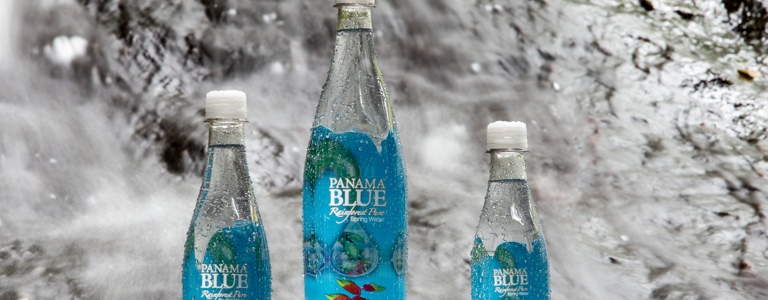
When looking at a bottle, the first thing that arguably captures one’s attention is the bottle design and the label. Panama Springs created a label design in which every element is connected to Panama and the region where the water is sourced. Ensuring an attractive design for the domestic and international market, the Panama Blue label fuses a number of colorful and creative elements.
Standing out in the mid-center portion of the bottle are leaves of the Pico de Loro flower (heliconia rostrata, also known as the “false-bird-of-paradise), a flowering perennial plant native to the Cerro Azul region. Against a blue background, which represents water, a green leaf – evoking the rainforest – with small droplets of water coalesces into an artistically styled picture in the shape of a larger drop of water with images of the forest, mountains, and again, water. Above this is the brand name, with “Panama” written on top and “Blue” underneath in a larger font. Indeed, even the font has a local historical relevance, as it was a popular typeface used in the mid nineteenth century, right when the Panama Railroad was being built. Use of this font signifies the sense of pride that the company takes in the fact that Panama Blue is a Panamanian product. On the back of the label is a scene designed by a local artist, which again captures the landscape, vegetation, and abundant water of the Cerro Azul region.
Panama Springs takes great pride in the design of the bottle and label of their signature product, and is well aware of the important role that the IP system plays in the SME’s business strategy. In order to secure the Panama Blue bottle design, in 2008 the company applied to have it protected as an industrial design with the Directorate General of the Industrial Property Registry of Panama. The application was approved and registered in 2011.
Trademarks and domain names
When Panama Springs designed the Panama Blue bottle and label, the company was not only eyeing the domestic market, but also international markets. To have a chance at success, the SME knew that protection of its Panama Blue brand name was crucial. To that end, in 2008 the SME filed a trademark application in the United States of America (USA) with the United States Patent and Trademark Office (USPTO). The complete trademark – Panama Blue 100% Rainforest Pure – was registered with the USPTO in 2010. Continuing with this international approach, the company made an application for a similar trademark – Panama Blue Rainforest Pure Spring Water – at the Office for Harmonization in the Internal Market, the body responsible for administering trademarks in the European Union. The trademark was registered in 2010.
Panama Springs has also recognized the importance of a presence on the Internet, and regularly utilizes popular social networking tools such as Facebook and Twitter. To further solidify its online presence, the company owns the panamabluewater.com domain name, which has an attractive design that allows consumers and business partners to learn more about Panama Blue water.
Branding
Backed by the IP system, Panama Springs has developed a robust and successful branding strategy for Panama Blue. The company has developed a branding image that evokes the beauty of Panama, the clearness and freshness of natural spring water, and the vital role it plays in an active lifestyle. To that end, the company traditionally uses bright colors that reflect the tropical nature of Panama and the refreshing and sustaining characteristics of natural spring water. The SME uses an eclectic array of brand awareness strategies, such as sponsoring marathons, musical concerts, and participating in industry events. In 2014, the company enjoyed a major branding milestone when it provided Panama Blue water to participants of the week-long “Internationale Tourismus Börse” (ITB), one of the world’s leading travel trade shows held in Berlin, the Federal Republic of Germany (Germany), and to all rooms at the Hotel Adlon Kempinski, a world-renowned luxury hotel and the ITB venue. Through these efforts Panama Springs reaches a wide audience. Moreover, not only has it resulted in a successful reception of the Panama Blue brand, but it has also allowed the company to compete with larger, multinational companies.
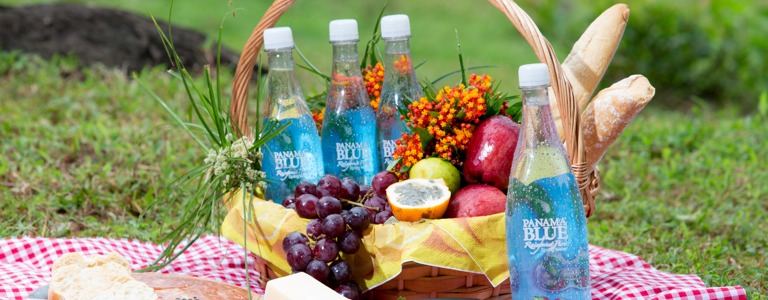
Commercialization
With a product that everyone needs (water), a unique bottle and label design, and industrial design and trademark applications made, Panama Springs wasted little time in the commercialization of natural Panamanian spring water. Panama Blue is bottled at the source, with the SME’s factory located at the top of the mountain near to where the natural aquifers are located. The company takes pride in that no trees were removed for the construction of the factory, and that Panama Springs’ operations provide employment opportunities for over fifty families in the region. Water is extracted through a network of stainless steel pipes that are fed from the surface directly into the aquifers at the top of the mountain. Sourcing from aquifers at higher elevation serves two important purposes. First, it ensures that extracted water is susceptible to a minimal risk of external contamination. If the factory were at the base of the mountain, pesticides in the soil from nearby farming could seep into the aquifers. Since there are no farming activities at the top of the mountain, bottling the water there minimizes this risk.

(Photo: Panama Springs)
Second, water from the aquifer does not have to travel far to reach the production facility, which further minimizes the chance that water would come into contact with outside air and potential contaminates in the air. One of the major reasons why the water from the Cerro Azul region retains its level of quality is because it comes from aquifers that have not been exposed to outside air. By collecting the water close to the source, and in combination with technologies such as pressurization and cleanrooms (a sealed environment with extremely low levels of environmental pollutants, such as ozone or carbon monoxide), the water does not come into contact with any outside air until a fresh bottle of Panama Blue is opened. This ensures the water’s quality and a long shelf life.
Although aquifer-sourced water needs far less purification than surface water, some filtering techniques are still necessary. During processing, Panama Blue water therefore is exposed to ultraviolet light, iron and manganese are eliminated, and a small amount of ozone is added. This destroys any possible impurities in the water and also eradicates any odor or taste that would come from the water being isolated underground for long periods of time. To ensure that Panama Blue remains natural, no preservatives added. In addition, in-house scientists test the water several times per day, and the water also undergoes regular testing at the Fresenius Institute Laboratories, a world-renowned chemical analysis laboratory in Germany, to ensure safety.
The first factory that was built to process and bottle Panama Blue had a capacity of over 1,200 boxes of 24, 500 milliliter (ml) bottles per week. Panama Springs initially focused on the domestic market, and shortly after launch Panama Blue could be found in supermarkets, restaurants, hotels, gyms, and convenience stores throughout Panama. In addition, individual consumers can order home delivery of Panama Blue. As production capacity increased, the SME was soon producing bottles in four different sizes: 330ml, 500ml, 1 liter, and 1 gallon (approximately 3.8 liters).
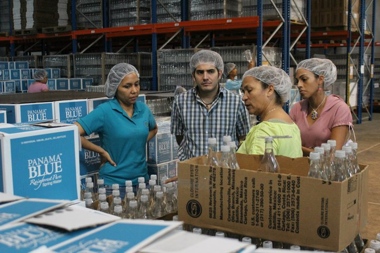
(Photo: Panama Springs)
After solidifying its presence in Panama, the company turned its attention to the international market. To that end, in 2014 Panama Springs constructed a new bottling plant on more than 250 hectares of land in close proximity to newly sourced aquifers. This will provide the company with increased production capacity, and will also allow Panama Springs to offer more bottle sizes and new products, such as sparkling and flavored water.
Representing the SME’s commitment to its customers – and with an eye on the international market – Panama Blue is the only bottling company from Panama to receive multiple certifications from the International Organization for Standardization (ISO), an organization based in the Swiss Confederation that develops international standards for a variety of industries. Thanks to the SME’s efforts, as of 2014 Panama Blue has received ISO:9001 (which sets out criteria for a quality management system) and ISO:14001 (which sets out criteria for an environmental management system) certification for six consecutive years. In addition, Panama Blue is certified with the National Science Foundation of the USA and utilizes the Hazard Analysis and Critical Control Points (HACCP) preventive approach for food safety. Certifications such as these give consumers, and potential business partners, confidence in the quality and safety of the Panama Blue brand. It also provides Panama Springs with a greater chance for international expansion and commercial success, such as securing new investments and distribution partners.
Business results
In only a few years, Panama Springs has been able to tap into an abundant natural resource, develop an innovative product design and name, and become one of the leading bottled water companies in Panama. For instance, Panama Blue is the official bottled water of Power Club, a popular chain of gyms in Panama; it is a sponsor of sporting, musical, fashion, and other events in the country; and it was the first Panamanian bottled water to be exported to North America.
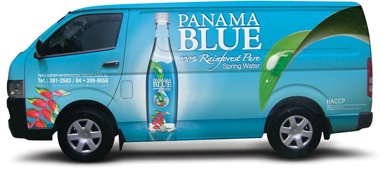
(Photo: Panama Springs)
Panama Blue is also exported to neighboring countries in Central America and sold at Kempinski Hotels in Frankfurt, Germany. One of the SME’s main goals is to bring more attention to Panamanian products through exporting Panama Blue water, and it has enjoyed success in this effort by reaching these international markets while it enhances its distribution network focusing on South American and European markets.
The unique design of the Panama Blue bottle and label has also been recognized internationally. In 2008, shortly after Panama Springs launched Panama Blue, the company received the Best PET Bottle award at the Water Innovation Awards, an annual international competition in the bottled water industry held in Wiesbaden, Germany. The company was also invited to showcase its innovative bottle design at the 2012 National Plastics Expo in the state of Florida, USA. Furthermore, in an effort to raise more investment in 2014 the company started selling bonds to selected investors.
A refreshing approach
With increased sales and production capacity – and backed by innovative designs, trademarks, and the IP system – Panama Blue has made a quick transformation from a relatively unknown company to a domestic industry leader. As the SME expands its product and IP portfolio, it is poised to bring refreshing and clean water – and a truly Panamanian brand – to people throughout the world.
Source: WIPO

 Client Focus
Client Focus